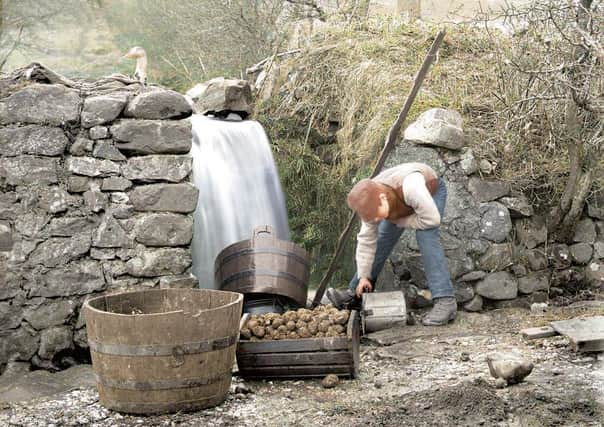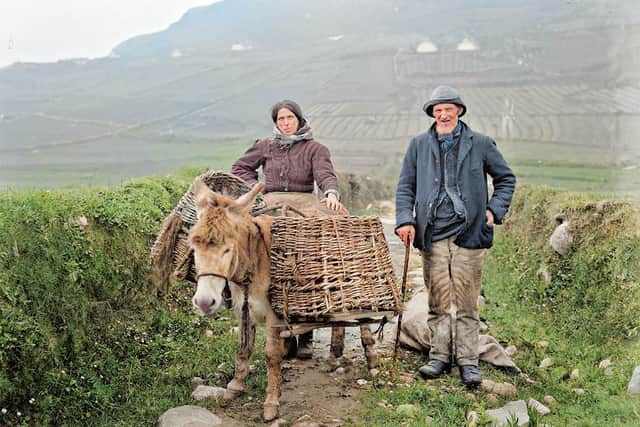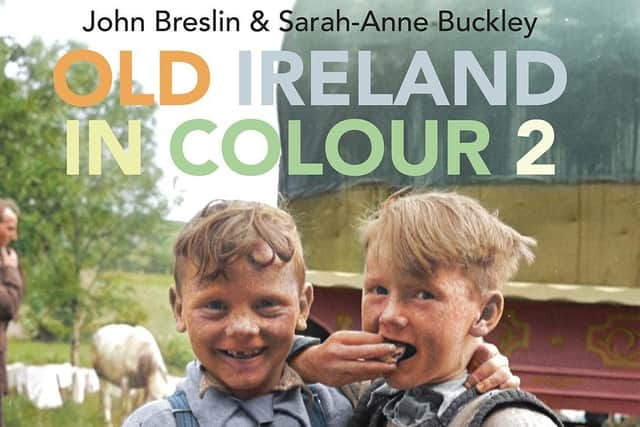Book’s fascinating photos of life in the Glens in years gone by


The book featured in every national newspaper, on The Late Late Show, on Ryan Tubridy’s radio show – it even made the homepage of CNN.
Now, Breslin and Buckley have delved even deeper into Ireland’s historical archives to uncover captivating photographic gems to bring to life using their unique blend of cutting-edge technology, historical research and expert colourisation.
Advertisement
Advertisement
Old Ireland in Colour 2 further celebrates the rich history of Ireland and the Irish people, from all walks of life, with all 32 counties represented across the full-colour title.


The latest edition of the book feature two fascinating photos from the Glens of Antrim.
One depicts a young boy ‘waling’ potatoes.
The author’s note reads: “WALING SPUDS c.1900, Glenariff, Co. Antrim. A boy ‘waling spuds’ at a waterfall.
“Welch noted on his original print: ‘Note the curious “washer” the potatoes are in. I never saw this anywhere but in the Glens of Antrim, where “waling spuds” was till lately, and still is in places, the term for washing potatoes. The bigger tub is only a barrel cut in two.’ While it is often argued that Sir Walter Raleigh introduced the potato to Ireland, it is far more likely that it was introduced by Sir Francis Drake from Spain.”


Advertisement
Advertisement
A second photograph from County Antrim is of a couple in the Glens collecting seaweed.
The note reads: “THE GLENS OF ANTRIM c.1900–1920. The Glens of Antrim cover some 80km of shoreline and feature a varied environment of grasslands, forests, peat bogs and mountain uplands.
“The Antrim Coast Road, built in the 1830s, stretches for nearly 160km and boasts some spectacular scenery. There are nine glens in all: Glentaisie, Glendun, Glenshesk, Glencorp, Glenaan, Glenballyemon, Glenarm, Glencloy and Glenariff. This image shows a couple collecting seaweed with a ‘Long saddle’ instead of a cart, with the near basket turned upside down.”
The book is divided into six sections under the broad headings of Politics and Revolution, Children and School, Working Life, Sport and Leisure, Ireland and the World, and Urban and Rural Scenes.
Advertisement
Advertisement
With over 150 superb images, once again accompanied by insightful captions, the book is the perfect portrait of life in Ireland throughout the nineteenth and twentieth centuries.
From the chaos of the revolutionary period to the simple beauty of the islands, from the iconic to the domestic, there is something new and inspiring to be gleaned from every single page.
John Breslin is a Professor at NUI Galway, where he has taught engineering, computer science and entrepreneurship over a 20-year period. He has written over 200 publications and co-authored two books.
Sarah-Anne Buckley is a lecturer in History at NUI Galway and President of the Women’s History Association of Ireland. She has published two monographs, four edited volumes and numerous articles. She is co-founder of the Irish Centre for the Histories of Labour and Class.
A hardback version of the book costs €24.95/£21.99.
ISBN: 9781785374111